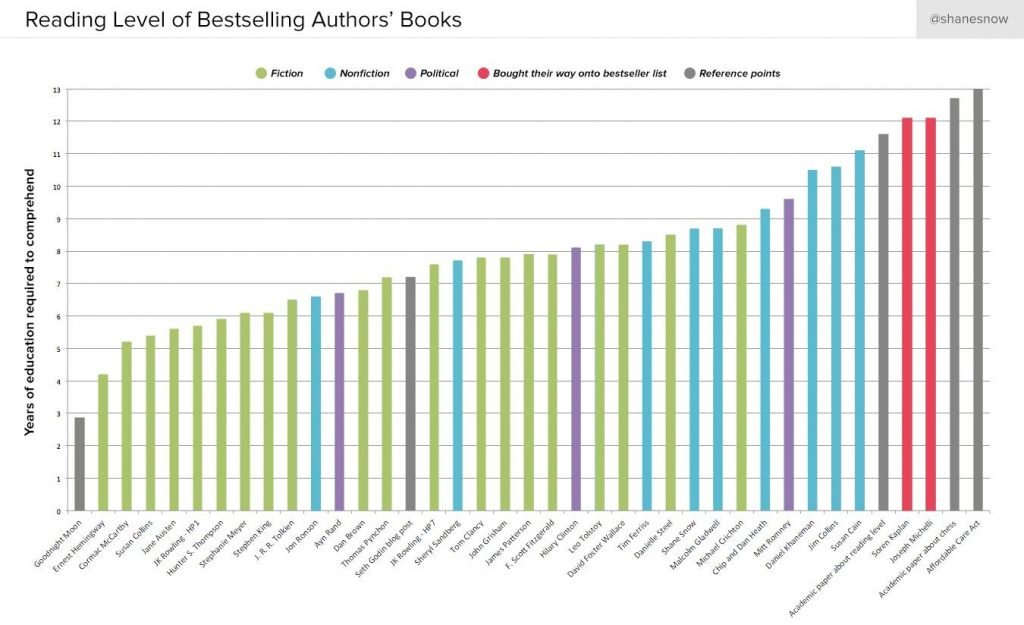(7 Rules You Can Implement Today – With No Experience Needed.)
Over the years, I’ve had the privilege to edit and publish a little over 1000 articles written by journalists from around the world.
From my time in the industry, I’ve noticed that the best writers are often not the best word-slingers.
It’s a wide misconception taught in journalism schools (and elsewhere) that the best authors write with an arsenal of colourful words – some words you or I don’t understand.
The truth is, the very best writers use metaphors, simple language, and no jargon.
If you think about it, the intention of writing is to get the reader to understand something.
Good writers have comprehensible sentences. But the best writers have memorable ones.
This draws back to that principle we’re all (hopefully) taught at school. That is: Keep It Simple, Stupid, or KISS for short.
Do you ever read something, and you have to reread it over, and over again to understand it properly?
This is an infamous example of bad writing.
Sorry, I mean TERRIBLE writing.
If your reader is unsure what they’ve just read, I would strongly recommend to scrap the sentence and start again.
You may ask: won’t this depend on the IQ of the reader?
Yes, but not everyone is a genius. In fact, most adults on average read at a grade 7-9 reading level.
According to the Flesch-Kincaid index, most world-famous authors write from grades 6-9:

Sure, some people can read at a bachelor’s level with no problem comprehending sentences, but most of us can’t.
You wouldn’t write an academic paper the same way you would write to the general public.
This is also true of advertising, teaching, and almost anything in life.
To remedy this, you must first understand your audience and then write for their average reading level.
How?
Well, for understanding your audience, you must envision your ideal readership, and solely write for them.
As for writing for average reading levels, there is a specific piece of software designed for this very purpose. It’s free to use and inspired by the famous Ernest Hemingway.
Hemingway was known for his love of minimalist writing. He deliberately wrote to communicate as succinctly as possible.
No fluff.
No writing for the sake of writing.
No jargon.
This software is available to you for free. Simply type “Hemingway app” into Google.

Hemingway was renowned for his famous Iceberg theory, which inspired many 20th-century writers.
Although I’m recommending this application, I implore you to use it as a guide only.
Sometimes you may have crafted a killer sentence, but the app marks it as too complex. Be mindful of this when using the app.
To help others to communicate better, I’ve listed a checklist of seven rules to follow below.
These rules were written five years ago. Over that time, they’ve been adopted by hundreds of journalists from around the world.
I urge you to adopt them for your writing journey, and refer to them as needed:
Rule #1 – An article must help your audience solve a pressing problem
This rule applies to guides, educational/informational pieces, and some news articles. Exceptions are opinion-based articles, and entertainment pieces.
Rule #2 – The article’s headline must rage with a burning desire to click on it
This rule applies to ALL literature. The only job of the headline is to get someone to read the article. Likewise for the image.
Rule #3 – Each subheading must incite curiosity
This rule applies to column-based feature articles, and books.
Rule #4 – Each sentence must be LESS than 20 words in length
This rule applies to ALL literature. In most cases, this can apply to paragraphs also.
A paragraph can consist of a single sentence, and since a single word can be a sentence, you can literally have a paragraph that consists of a single word. – WordCounter
Rule #5 – NO writing for the sake of writing, or waffling on
This rule applies to ALL literature. This is infamously seen in academia.
Rule #6 – Read sentences aloud. If they’re hard to understand, start over
This rule applies to ALL literature. The entire purpose of writing is to get the reader to comprehend something.
Rule #7 – Your article must serve a purpose
For example, if you’re writing on behalf of a service-based company, ensure that the article is helping the sales and marketing teams. By understanding the buyer’s journey, you can write articles that serve a purpose.


